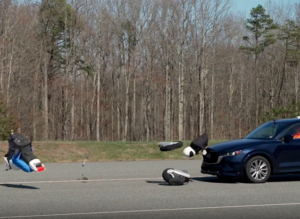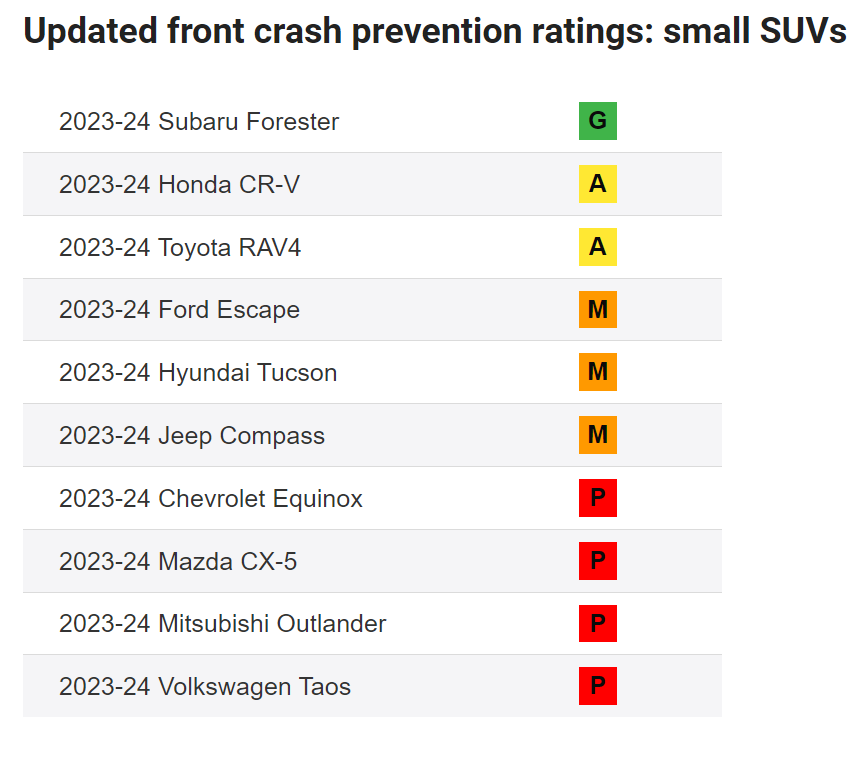
IIHS updates front crash prevention test, only one small SUV rated highly
By onAnnouncements
The Insurance Institute for Highway Safety (IIHS) recently updated its vehicle-to-vehicle front crash prevention test and found only one of the 10 small SUVs evaluated earned a good ranking.
Speeds for the test were increased from 12 and 25 mph to 31, 37, and 43 mph, according to an IIHS press release. The test also added motorcycles and large trucks as vehicles that were struck.
“This is a vital update to one of our most successful test programs,” IIHS President David Harkey said in the release. “The vast majority of new vehicles now come with automatic emergency braking, and our research shows the technology prevents as many as half of all front-to-rear crashes. This new, tougher evaluation targets some of the most dangerous front-to-rear crashes that are still happening.”
The test focuses on some of the most popular small SUVs on the market. The Subaru Forester was the only one in the group to earn a good rating in the updated test, the release says. The Honda CR-V and Toyota RAV4 received an acceptable rating. The Ford Escape, Hyundai Tuscan, and Jeep Compass earned marginal ratings. The vehicles that earned poor ratings include the Chevrolet Equinox, Mazda CX-5, Mitsubishi Outlander, and Volkswagen Taos.
“The original vehicle-to-vehicle front crash prevention evaluation was developed when the technology was relatively new, so the performance requirements only addressed low-speed crashes,” the report says. “By the time the original evaluation, with test runs at 12 and 25 mph, was discontinued at the end of 2022, all tested vehicles were earning the top rating of superior.”
As the number of vehicles with advanced driver assistance systems (ADAS) has increased, data has shown the systems are less effective at preventing crashes at higher speeds and with crashes involving motorcycles and medium or heavy trucks, the release says.
Updating the test was needed to reflect the greater portion of police-reported front-to-rear crashes, the release says.
“Obviously, crashes that happen at higher speeds are more dangerous,” said IIHS Senior Research Scientist David Kidd, who led the development of the new evaluation. “Deadly underride crashes often occur when the struck vehicle is a large truck, and motorcyclists are frequently killed when they’re rear-ended by a passenger car, since their bike offers no protection from the impact.”
The test used passenger vehicles, motorcycles, and a dry van trailer as targets. The passenger vehicle and motorcycle were positioned in the center of the travel lane and offset to the left or right. The trailer was positioned in the center of the lane.
Forward collision warnings and automatic emergency braking (AEB) systems were tested in the trials. An engineer driving the test vehicles recorded when forward collision warnings occurred and how much the AEB system slowed the vehicle to prevent or mitigate the impending impact, the release says.
Only the forward collision warning system is evaluated in the test runs using the trailer and the driver steers out of the lane to avoid the crash.
The release says the vehicles earned points for warnings that occurred at least 2.1 seconds before the projected time of impact and for substantial speed reductions in the AEB tests. Speed reductions accounted for two-thirds and warnings accounted for one-third of the maximum possible score.
“The good-rated Forester avoided a collision with the passenger car target at every test speed, avoided hitting the motorcycle target at 31 and 37 mph, and slowed by an average of 30 mph before hitting the motorcycle target in the 43 mph tests,” the release says. “The forward collision warning alerts also came more than the required 2.1 seconds before the projected time of impact in all those trials and also in those conducted with the trailer.”
Honda’s CR-V was able to provide a timely forward collision warning alert and came to or near a stop on every trail with the passenger car target and in the 31 and 37 mph trials with the motorcycle, the release says. It failed to slow consistently in the 43 mph trials with the motorcycle.
“Even vehicles with a marginal rating in the new test demonstrate a higher level of performance than what was required for the highest rating in the original vehicle-to-vehicle front crash prevention evaluation,” the release says.
The Escape avoided hitting the passenger and motorcycle target at the 31 mph test speeds and slowed by a modest amount in the higher speed tests, the release says. Yet, it lost points because its forward collision warning came too late in all of the 31 mph tests.
Of those that rated poorly, they missed the mark in multiple scenarios, the release says.
“For example, the Equinox provided a timely forward collision warning in the tests with the trailer and passenger car target but either failed to give a warning or gave it too late in most tests with the motorcycle target,” the release says. “With the passenger car target, it slowed modestly in the 31 mph tests, and with the motorcycle target it barely reduced speed at all.”
California state legislators have recently drafted bills in an attempt to combat speeding as the number of deaths, specifically on Pacific Coast Highway (PCH), continues to rise, according to the Los Angeles Daily News.
There have been more than 60 deaths on the highway since 2010, according to the article. It says the death of four Pepperdine University students struck by a driver traveling at 104 mph has renewed concerns about speeding in the state.
Crash data released by the National Highway Safety Administration earlier this month shows 18% of all drivers involved in a fatal crash in 2022 were speeding at the time of the crash. It also says speeding was related to 29% of all fatal crashes during that time period.
Overall, 12,151 people died in speed-related crashes in 2022; a slight decrease from the 12,498 killed in 2021.
IMAGES
Feature photo screenshot of IIHS provided video.

